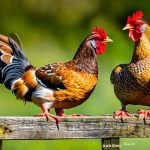Understanding heat stress in animals is crucial for their well-being during hot weather. Like humans, animals can experience heat stress and heat stroke if not properly cared for in high temperatures. Signs of heat stress in animals include excessive panting, drooling, lethargy, and weakness.
Animals may also seek cool, shady areas and exhibit decreased appetite. Recognizing these signs is essential for prevention. Different animals have varying needs when it comes to heat tolerance.
Animals with thick fur coats may be more susceptible to overheating, while those with thinner coats may be better adapted to handle high temperatures. Species-specific temperature preferences and tolerances must be considered when providing care during hot weather. Environmental factors play a significant role in heat stress for animals.
High humidity, lack of shade, and limited access to water can exacerbate the effects of heat. Understanding these factors allows caretakers to implement measures to mitigate their impact and create a more comfortable environment for animals. By comprehending the effects of heat on animals and their specific needs, caretakers can take proactive steps to ensure their comfort and safety during hot weather.
This knowledge is fundamental in providing optimal care for animals in high-temperature conditions.
Table of Contents
- 1 Providing Shade and Ventilation
- 2 Offering Cool Water and Electrolytes
- 3 Using Misters and Fans
- 4 Adjusting Feeding and Foraging Times
- 5 Creating Dust Baths
- 6 Monitoring for Signs of Heat Stress
- 7 FAQs
- 7.1 What are the best ways to keep chickens cool in Texas?
- 7.2 How can I provide shade for my chickens in Texas?
- 7.3 What are some tips for providing fresh water to chickens in Texas?
- 7.4 How can I improve ventilation for my chickens in Texas?
- 7.5 What are some ways to use misters and fans to keep chickens cool in Texas?
- 7.6 What are some frozen treats I can give my chickens to help keep them cool in Texas?
Key Takeaways
- Understanding the heat is crucial for preventing heat stress in animals
- Providing shade and ventilation helps animals stay cool in hot weather
- Offering cool water and electrolytes is essential for keeping animals hydrated
- Using misters and fans can help lower the temperature in animal enclosures
- Adjusting feeding and foraging times can help animals avoid the hottest part of the day
- Creating dust baths can help animals regulate their body temperature
- Monitoring for signs of heat stress is important for ensuring the well-being of animals
Providing Shade and Ventilation
Shade: A Crucial Element
One of the most important ways to keep animals cool during hot weather is by providing them with ample shade. Shade is essential for protecting animals from direct sunlight and providing them with a cool place to rest. This can be achieved by providing natural shade from trees or by creating artificial shade using structures such as awnings or tarps.
Ventilation and Orientation
Additionally, ensuring that there is proper ventilation in animal enclosures is crucial for allowing air to circulate and prevent the buildup of heat. Furthermore, it’s important to consider the orientation of animal enclosures in relation to the sun. By positioning enclosures so that they receive minimal direct sunlight during the hottest parts of the day, you can help to keep animals cool and comfortable.
Materials Matter
In addition to providing shade and ventilation, it’s important to consider the materials used in animal enclosures. Materials such as metal or concrete can absorb and retain heat, making them unsuitable for use in hot weather. Instead, using materials that reflect heat, such as light-colored or reflective surfaces, can help to keep animal enclosures cooler.
Overall Importance
Overall, providing shade and ventilation is essential for keeping animals cool and comfortable during hot weather. By considering these factors, you can help ensure the well-being of animals in your care.
Offering Cool Water and Electrolytes

Offering cool water and electrolytes is essential for keeping animals hydrated and healthy during hot weather. Just like humans, animals need access to plenty of water to stay hydrated and regulate their body temperature. Providing cool water for animals to drink is crucial for preventing dehydration and heat stress.
Additionally, offering electrolyte supplements can help to replace essential minerals lost through sweating and panting. Furthermore, it’s important to ensure that water sources are kept clean and free from contaminants. Regularly cleaning water troughs and bowls can help to prevent the growth of harmful bacteria and algae, ensuring that animals have access to clean, safe drinking water.
Additionally, providing multiple water sources throughout animal enclosures can help to ensure that all animals have access to water, even in larger groups. In addition to offering cool water and electrolytes for drinking, it’s important to consider other ways to keep animals cool and hydrated. For example, providing access to shallow pools or misting systems can help animals to cool off and regulate their body temperature.
Overall, offering cool water and electrolytes is essential for keeping animals hydrated and healthy during hot weather.
Using Misters and Fans
Using misters and fans is an effective way to help keep animals cool during hot weather. Misters can be used to create a fine spray of water that helps to lower the ambient temperature and provide a cooling effect for animals. This can be especially beneficial for animals with thick fur coats or those that are particularly sensitive to heat.
Additionally, using fans to circulate air can help to create a cooling breeze and prevent the buildup of heat in animal enclosures. Furthermore, misters and fans can be strategically placed in animal enclosures to provide maximum cooling benefits. For example, misters can be positioned near resting areas or feeding stations to provide animals with a cool place to rest and eat.
Similarly, fans can be used to create airflow in enclosed spaces or areas where natural ventilation is limited. In addition to using misters and fans in animal enclosures, it’s important to consider their maintenance and operation. Regularly cleaning misters and fans can help to prevent the buildup of dirt and debris that can reduce their effectiveness.
Additionally, ensuring that misters and fans are properly positioned and functioning optimally is essential for providing animals with the best possible cooling benefits. Overall, using misters and fans is an effective way to help keep animals cool during hot weather.
Adjusting Feeding and Foraging Times
Adjusting feeding and foraging times can help to keep animals cool and comfortable during hot weather. Feeding animals during the cooler parts of the day, such as early morning or late evening, can help to prevent them from overheating while eating. Additionally, providing access to fresh food at these times can help to ensure that animals are well-nourished and hydrated during hot weather.
Furthermore, adjusting foraging times for animals that rely on grazing or browsing can help to prevent them from being exposed to excessive heat while searching for food. For example, allowing grazing animals access to pasture during cooler parts of the day can help to prevent them from overheating while foraging for food. Additionally, providing access to shaded areas near grazing areas can help animals to rest and cool off between foraging sessions.
In addition to adjusting feeding and foraging times, it’s important to consider the nutritional needs of animals during hot weather. Providing access to high-quality forage or feed that is rich in water content can help to keep animals hydrated and well-nourished. Additionally, offering supplemental feed or treats that are specifically designed to help animals stay cool during hot weather can provide additional benefits.
Overall, adjusting feeding and foraging times is an important way to help keep animals cool and comfortable during hot weather.
Creating Dust Baths

The Benefits of Dust Baths
Dust baths are a natural behavior for many species of animals, including birds, small mammals, and reptiles. Rolling in dust or dry soil helps these animals to remove excess oils from their skin and fur, as well as parasites such as mites or lice.
Providing Dust Baths in Captivity
Creating dust baths for animals in captivity can help to mimic their natural behavior and provide them with an opportunity for enrichment. Providing a shallow container filled with fine dust or dry soil allows animals to engage in this natural behavior while also helping them stay cool and comfortable during hot weather.
Maintenance and Cleanliness
In addition to creating dust baths, it’s essential to consider their maintenance and cleanliness. Regularly replacing dust or soil in dust baths can help to prevent the buildup of dirt or contaminants that could be harmful to animals’ skin or fur. Additionally, ensuring that dust baths are positioned in shaded areas can help to prevent them from becoming too hot or uncomfortable for animals to use.
Monitoring for Signs of Heat Stress
Monitoring for signs of heat stress is essential for ensuring the well-being of animals during hot weather. Regularly observing animals for signs such as excessive panting, drooling, lethargy, or weakness can help to identify potential issues before they become more serious. Additionally, monitoring changes in behavior or appetite can provide valuable insights into how animals are coping with the heat.
Furthermore, it’s important to consider individual differences in how animals respond to heat stress. Some animals may be more sensitive to heat than others, particularly those with thick fur coats or respiratory issues. By monitoring individual animals closely and being aware of their specific needs, you can take proactive measures to prevent heat stress from occurring.
In addition to monitoring for signs of heat stress, it’s important to have a plan in place for addressing any issues that arise. This may include providing immediate access to shade or cool water, as well as seeking veterinary care if necessary. Additionally, having a protocol for managing heat stress in place can help ensure a timely response if an animal does show signs of distress.
Overall, monitoring for signs of heat stress is essential for ensuring the well-being of animals during hot weather. By being proactive in observing animals closely and responding quickly if issues arise, you can help keep them cool and comfortable even in the hottest temperatures.
If you’re looking for more tips on keeping your chickens comfortable in the Texas heat, you might want to check out this article on how to insulate a chicken coop. Insulating your coop can help regulate the temperature and keep your chickens cool during the hot summer months.
FAQs
What are the best ways to keep chickens cool in Texas?
In Texas, it’s important to provide shade, plenty of fresh water, and good ventilation for your chickens to keep them cool. You can also use misters, fans, and frozen treats to help lower their body temperature.
How can I provide shade for my chickens in Texas?
You can provide shade for your chickens by using natural shade from trees or building a shade structure such as a covered run or a tarp over part of the coop.
What are some tips for providing fresh water to chickens in Texas?
In Texas, it’s important to provide fresh, cool water to your chickens at all times. You can use automatic waterers, add ice to their water, or use shallow dishes that are easy to clean and refill frequently.
How can I improve ventilation for my chickens in Texas?
You can improve ventilation for your chickens by adding windows, vents, or fans to their coop. Good air circulation is essential for keeping chickens cool in the Texas heat.
What are some ways to use misters and fans to keep chickens cool in Texas?
Misters and fans can be used to create a cooling breeze and lower the temperature in the chicken coop. You can set up misters on a timer and use fans to circulate the air and keep the chickens comfortable.
What are some frozen treats I can give my chickens to help keep them cool in Texas?
You can freeze fruits, vegetables, or even mealworms in ice cubes or blocks of ice to give to your chickens as a refreshing treat. This can help lower their body temperature and provide some relief from the heat.
Meet Walter, the feathered-friend fanatic of Florida! Nestled in the sunshine state, Walter struts through life with his feathered companions, clucking his way to happiness. With a coop that’s fancier than a five-star hotel, he’s the Don Juan of the chicken world. When he’s not teaching his hens to do the cha-cha, you’ll find him in a heated debate with his prized rooster, Sir Clucks-a-Lot. Walter’s poultry passion is no yolk; he’s the sunny-side-up guy you never knew you needed in your flock of friends!







